Texas All Right (8:30, 30°N, 100°W)
Whoa! Now we are in Texas all right:

I've slept through all the shunting in San Antonio, and thus only noticed in the morning that my sleeper car, previously right behind the Texas Eagle's engine, is now running at the rear of the Sunset Limited. Being at the end of the train has to two great advantages: For one, the engine's hooting is a lot fainter now. And we get to enjoy the view out of the rear window. That was the first thing I did when I got up at dawn. Clearly, we are now heading straight west, away from the rising sun:
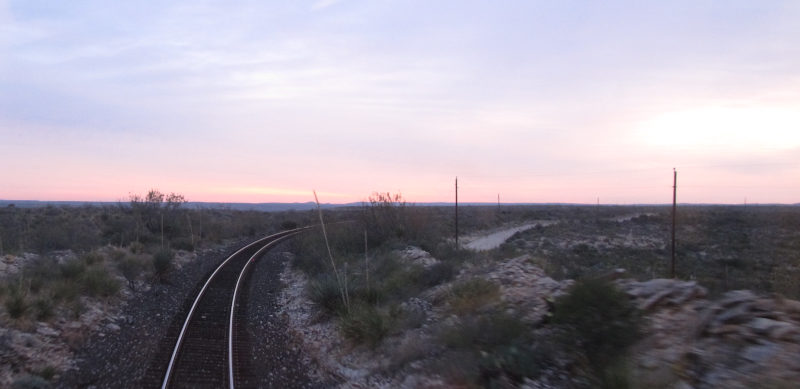
The new train brings with it a few amenities we had to do without on the Texas Eagle. For one, they now have real cutlery in the dining car (well done, Amtrak!), and there are plenty of vegetarian options for breakfast (I had French toast). There's also a new menu for lunch. I'm grateful for some change over the “Kofta Kebaps”, which was the only vegetarian item on the Texas Eagle's lunch and dinner menu and became a bit boring the third time I had it.
We now also have a lounge car with panorama windows. Given that the landscape has just turned from the endless plains between Chicago and San Antonio to rather spectacular, that's a welcome addition. And it reminds me of a story I read about when I looked up Amfleet cars (I rode in one from Boston to Chicago). I had always wondered why the windows of these were so small. Turns out – at least according to some Wikipedia author – that was a design decision to make them seem more like planes. Can you believe that^ Between the cabins of a plane and a train, who would go for plane? But then… similar considerations might explain why the French TGV cabin looks the way it does. Hm.
Let me enjoy the large windows of the lounge car for a while.
In the Lounge Car (9:40, 102°W)
I got a seat all right in the lounge car. They swivel! This is actually less silly than it might sound, because, indeed, sometimes there's more going on on the left side, sometimes the right window has the better views. Outside, there are now many hills with dry valleys between them, some hardy plants somehow manage to remain some shade of green – and occasionally there is something looking like a farm, though I cannot work out what they farm on.

Meanwhile, I was wondering what the “Limited” might mean on the names of trains like this one – or the Lake Shore Limited that got me to Chicago.
My chance to figure that out was when the breakfast staff put me on a table with two fellow travellers who also have been on board since Chicago. They turned out to be retired Union Pacific employees – who would be better qualified to answer such a question? So, it appears that in the early 1900s there was a luxury train connecting, I think, New York and Chicago, that was called the Whatever Limited for reasons long forgotten. But that seems to have established the notion that “Limited” trains are somehow particularly posh, and that's why many other railway companies used that label – and, in their heritage, so does Amtrak now.
Perhaps it's a bit like “Waldorf“, which originally was just a homage to the Astoria's founder's birthplace, a town near Heidelberg that today is the home of SAP.
Be that as it may, “posh” is not the association I'd have with this lounge car. It actually is, at least at this time, pretty much a showcase of US social reality, with people hanging on to their last two teeth giving testimony of just how broken the healthcare system is over here. So, after enjoying the almost-360° view for a while I decided that I had better not hog that extra space.
Meanwhile, somewhere around 101° West or so, there was this house:
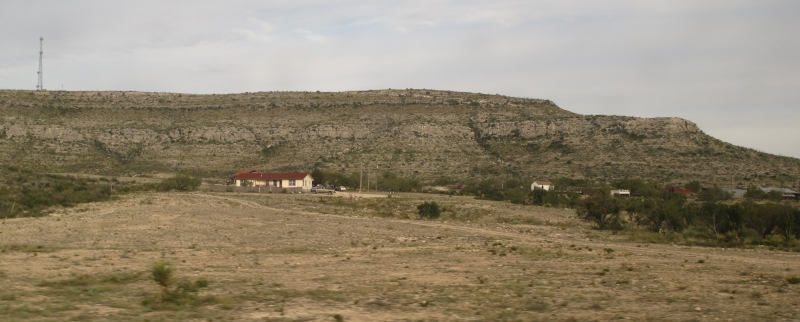
I suppose you have to crave, well, space a lot if you move into this sort of desolation.
No Signal (11:30, 104.3°W)
Well, who knows: Perhaps you move out here just because you hate cellphones and the internet a lot. Because this is no-signal country.
The Sunset Limited doesn't have on-board internet, and of course a little cellphone usually has no signal at all out here in southwestern Texas. As someone who lives without a (connected) cellphone most of the time, I have a lot of sympathy for that, and I wonder what influence Starlink or other future satellite networks will have on places like this.
Still, I cannot resist remarking that it's somewhat ironic that in the place when you would most likely need to place emergency calls with your cellphone, you generally cannot.
In the end I uploaded a first version of this post at Alpine, TX, where there is cellphone coverage. It's a cute little town at the surpringing height of 1350 metres above sea level:
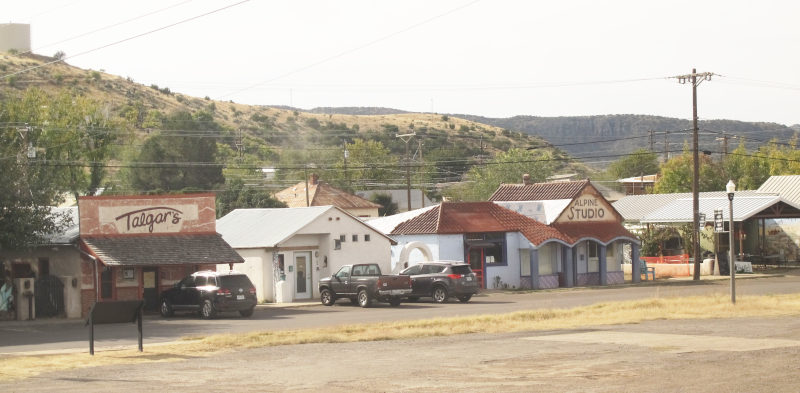
The Wikipedia has a droll story about the place:
[Around 1882, t]he railroad needed access to water from springs owned by brothers named Daniel and Thomas Murphy, so it entered into an agreement with the Murphys to change the name of the section and settlement to Murphyville in exchange for a contract to use the spring.
It didn't last long, as the residents didn't like the name. I have to give them that Alpine is a fairly apt name, as there are pretty mountains around the town. They have a quite decidedly non-alpine look, though:

Towards El Paso
Now that my desert-wise expectations on Texas have been satisfied, a big lacuna still is cattle. Yes, I've seen the occasional little herd here and there, and one could see horses now and then, but my fantasy of great herds in the pairie has not found a basis in reality. Neither will it going forward, since we are now in El Paso and hence will be in New Mexico any moment. Texas is big; it took us from yesterday morning to this noon to cross it (admittedly not on the shortest path, and not always going something like 100 km/h, and with a four-hours break in San Antonio).
At least one part of the cattle fantasy had a blink of reality, in that in the outskrits of Alpine I saw this:
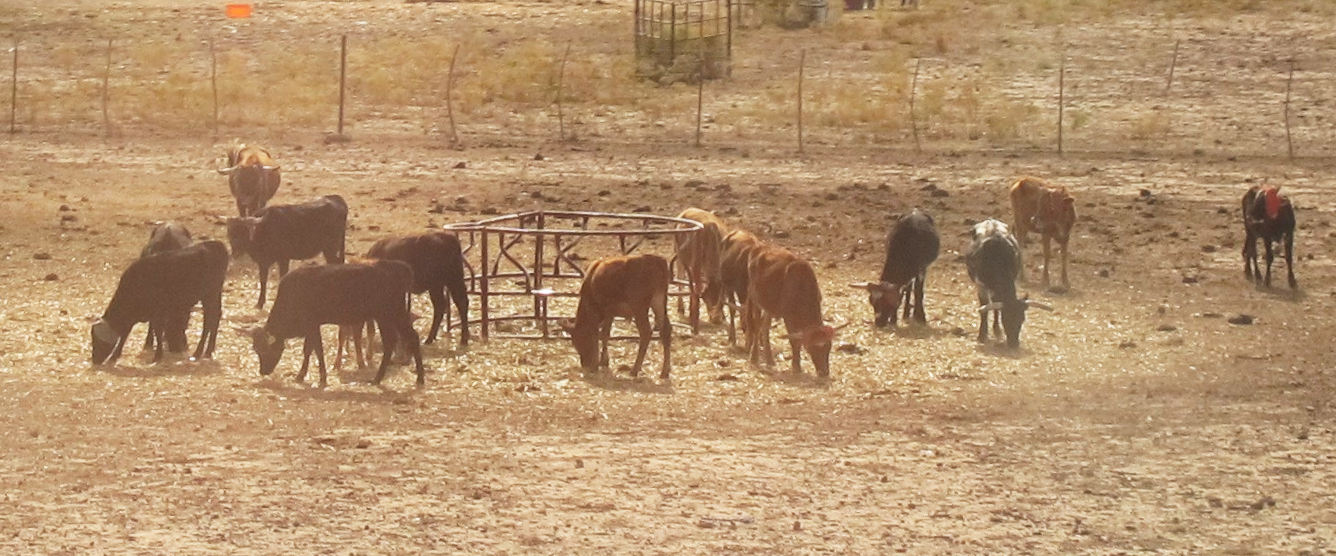
Fairly impressive horns! Frankly, I'm not sure I would like to herd these.
I was also reinforcing my Texas stereotypes is when I looked out of the rear window on one of the mountain-ringed high plateaus there. Consider the following picture giving both and endless railway to the horizon and an endless (if empty) freight train that was parked next to the main track:
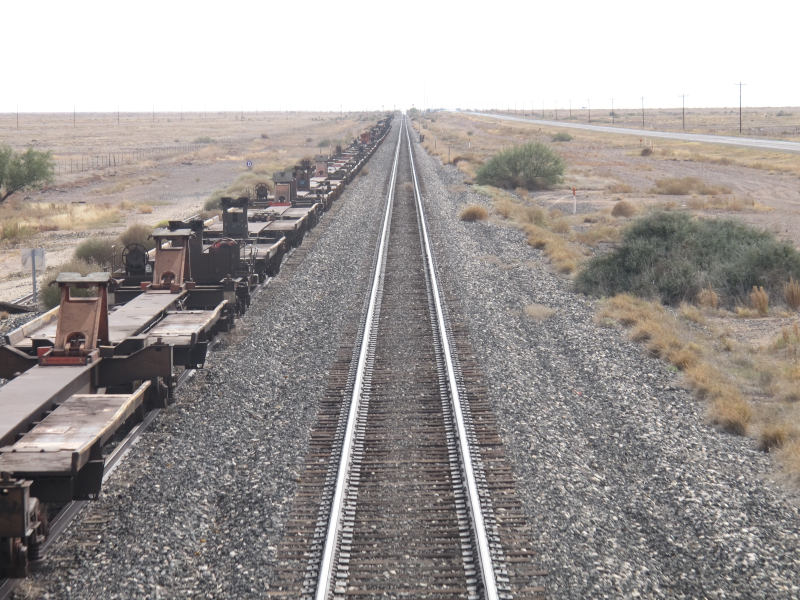
Borders and Fences (15:20, 107°W)
In El Paso, the train again had a longer stop, and I could convince myself from the outside that there are two engines pulling this train:
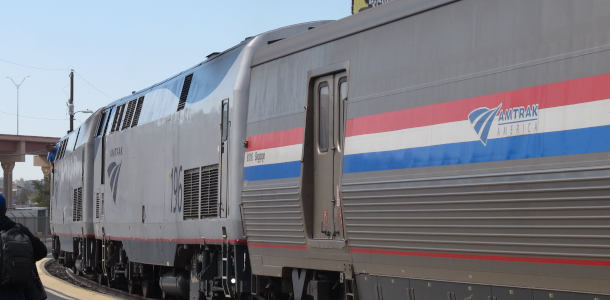
Given my considerations yesterday, it would seem we are looking at almost 7 Megawatts of maximum traction power here, or a whopping 25 Porsche Cayenne Hybrids. That would be two kindergarten groups, I suppose. The hybrids, by the way, are a good analogue, as they, like most Diesel locomotives, have a combustion engine driving a generator producing electricity for the motor.
I wonder how much of the double traction is for fault tolerance and how much of that power they really need. Granted, the train had to do quite a bit of climbing from 200 metres in San Antonio to 1400 metres near Alpine, but that was over a distance of several hundred kilometers. Meanwhile, the train never ran particularly fast; I've never seen it go more than 120 km/h. Ah, who knows?
The car right behind the two locomotives is a baggage car, by the way. That's another thing I could get romantic about. It used to be that Deutsche Bahn (DB) had a baggage car with (virtually) every train, and you could check your bicycle there. Sure, for bicycles the current mode (just take them with you, at least on regional trains, usually entering without stairs) is dramatically more convenient than hauling the bicycles up and down the oftentimes rather high boards. But still, it was nice that DB could get you reasonable sorts of cargo basically anywhere. Amtrak, it would seem given what they unloaded in El Paso, uses the baggage cart pretty much exclusively for checked baggage. Aw, what a waste.
While I was enjoying the sun on the platform, a freight train came in from the south. It was one of those endless, slow-moving affairs, and I idly watched it go by, noting all the different railway companies that had their cars in there. Until one boxcar had an open door:

Of course, every single Hobo story immediately jumped to my mind. Indeed, El Paso is exactly on border to Mexico, so it is absolutely plausible that some poor souls had just risked their lives aboard that train and left it before a US customs inspection.
A short stretch after El Paso, we had a good view of the border installations towards Mexico:
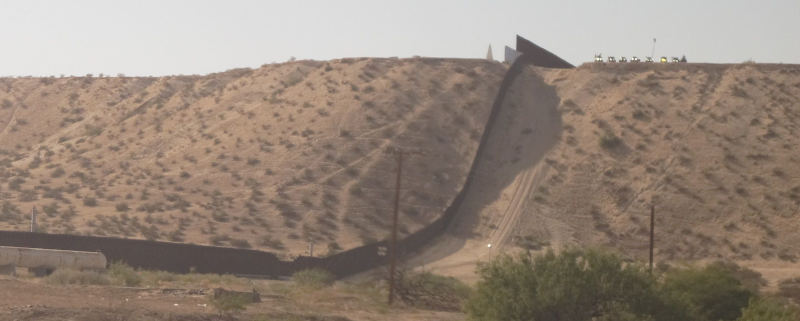
You know what that view reminded me of? The Roman border installations (not “fortifications“ by any means) in their provinces Germania Superior and Raetia, better known as the “Limes“.
When they felt like it, the just went straight across hills and through valleys, too. By no means the most striking illustration – but the most striking for which I have made a photo – is close to a small village in Baden-Württemberg called Grab („grave“). As all along the Germania Superior Limes, the Romans had cleared a swathe in the forest, then built a palisade and finally a rampart, all that guarded by a line of watchtowers. Here's how this looks like today, where the Limes went from where I was standing up the slope to the reconstructed watchtower:
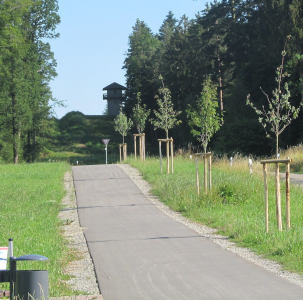
Well – this is probably what happens along any border with a steep gradient in (at least perceived) wealth; then as now this was about controlling trade and migration.
Refueled (16:40, 108.7°W)
A little bit west of El Paso, our train pulled into a refueling yard – the conductor was kind enough to explain it, only I forget that facility's name. Anyway, it's giant:

We were not speeding in the yard, but still: it took us minutes to cross it. Quite a view, including one of a medium-sized silo labeled “Soap” (presumably for cleaning cars and engines, as the minute amounts of soap dispensed in the on-board bathrooms come from small plastic bottles).
It was also a memento of what makes us move, as are the soot clouds we sometimes leave behind. I have not figured out what has to happen for the engines to emit one, but in particular when observing through the rear window, when it happens it's fairly conspicuous:
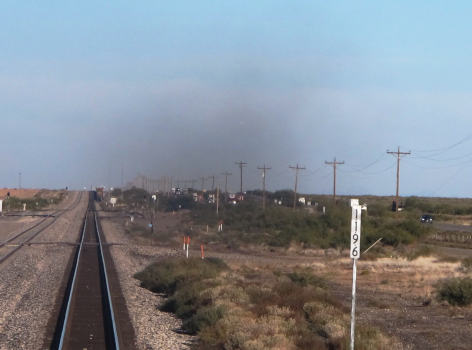
At least it dissolves a lot more quickly than a contrail, so people may not notice it. Still, keeping in mind the dire words for Californians…
Of course, in this particular place that cloud of soot doesn't matter much, since the line of poles you see on the right side of the photo mark the Interstate 10 with orders of magnitude more soot emission (not to mention other nasty stuff). Having that parallel to us has the additional advantage that we have more or less continuous cellphone coverage. It is a bit snotty of the telephone companies that the cover the interstates but not the long-haul railways, no?
Always Take a Peg With You (17:20, 109.2°W)
When I came into Amtrak's “economy bedroom“ that I have now been inhabitating for almost 50 hours, I was somewhat worried I might not have power in there. There was a socket, but it was marked “for razors only”, and the plug I had just fell out. There was zero grip in the socket, and even if I held plug in place, there was no juice in the cable.
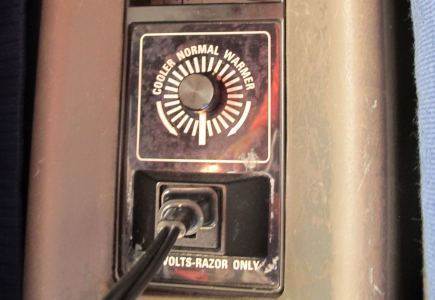
Incidentally, for my taste the “normal” setting of the air condition should be marked “cold”.
The attendant promised it's ok to plug in devices other than razors, too, and I eventually figured out that when I bend the two prongs of the plug together gently, they at least make contact. Without some external strain relief, the plug would still fall out at the smallest disturbance. Which gives me a first-class opportunity to proclaim Anselm's extension to Douglas Adams' good advice to always carry a towel: Take a few pegs, too.
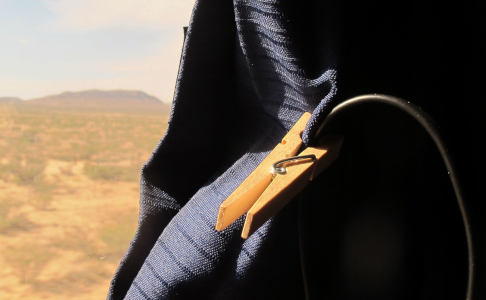
I have to say that I found Amtrak to be charmingly relaxed about several other rules that sounded perhaps a bit alarming at first. This began at Boston's South Station, when the “security“ movies they showed on a monitor in the waiting area seemed to require a badge on one's baggage. I asked at the information desk, and the guy there just reassuringly said that would totally be up to me. Indeed, I have not seen many badges on people's baggage in the past four days.
Getting on the train was – my mild anxiety aside – a matter of simply walking onto the platform, just as with a DB train. No x-raying baggage (no joke: they do that on the Chinese high-speed trains), no body scanners or pat-downs as for airlines – you just enter, show your ticket, and that's it. This is how travel should be. Also, although the the El Paso station actually featured barbed wire –

– station access was always easy and did not involve any security checks or something like that. Kudos to everyone that kept Amtrak reasonably unaffected of overly tangible security circus.
And yes, I can totally live with the occasional speaker announcemnt that one should let „street language on the street“ (imagine this pronounced by the cowboy in The Big Lewbowski to get an idea of what I had the privilege to listen to this morning). Have they really ever thrown someone out for cursing?
Preparing for Farewell (19:00, 110.55°W)
Long live the Sunset Limited! This last dinner – while I ate, the sun set over Arizona – consisted of actual, freshly made food, and I had nice company, too, another retired couple who related their memories of trips into Eastern Europe in the 1970ies. What a wonderfully cultivated way of getting from A to B.
Alas, that's coming to an end just about now – it's perhaps half an hour until Tucson. Farewell, my nice little roomette. Instead of the obligatory sunset, let me put in a somewhat nostalgic photo of a wind wheel (I think they're using them to pump up water, right?) in the desert of west Texas I took this morning:

Thanks for reading my little travelogue! And if you're a US citizen, can I ask you to go to your Congressperson and thank them for having kept Amtrak alive?
![[RSS]](./theme/image/rss.png)